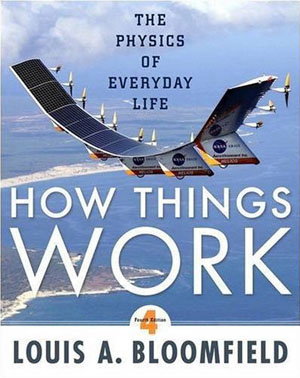| |
|
|
Site Map
QUESTIONS AND ANSWERS
COURSE INFORMATION
At UVa:
BOOK INFORMATION
INSTRUCTION INFORMATION
PRESENTATION INFORMATION
READER PARTICIPATION
MISCELLANEOUS
|
|
|
How Things Work: The Physics of Everyday Life
Louis A. Bloomfield
ISBN 978-0-470-22399-4, 614 pages, full-color, paperback, © 2010 |
|
 |
The 4th edition of "How Things Work: The Physics of Everyday Life" is now available from John Wiley & Sons. This textbook examines 42 objects or activities in our everyday world and serves both as a comprehensive introduction to physics and as a guide to how many of the objects around us work. It is intended as a text for liberal arts students in a one or two semester survey course. What makes this essentially non-mathematical text unusual is that it begins with the objects and looks within them for the concepts of physics. It is first and foremost a book about those objects.
— Lou Bloomfield, Professor of Physics, University of Virginia
| 
|
|
"Whether a curious layperson, a trained physicist, or a beginning physics student, most everyone will find this book an interesting and enlightening read and will go away comforted in that the world is not so strange and inexplicable after all."
— Carl Wieman, Nobel Laureate in Physics 2001, and Case/Carnegie US University Professor of the Year 2004 |
How Things Work: The Physics of Ordinary Life
is appropriate for:
- College or high school introductory physics courses that aim to teach more than factoids and formulas
- Continuing education courses for adults who want to understand the physical and technological world around them
- College or K-12 teachers who need supplementary materials for their classes
- Children who are being homeschooled and who will benefit from studying physics they can understand and find relevant
- Libraries that need educational resource materials
- Science museums that are teaching real physics as outreach activities
Table of Contents |
| Chapter 1 |
|
The Laws of Motion, Part 1 |
|
Chapter 9 |
|
Resonance and Mechanical Waves |
Section 1.1 |
|
Skating |
|
Section 9.1 |
|
Clocks |
Section 1.2 |
|
Falling Balls |
|
Section 9.2 |
|
Musical Instruments |
Section 1.3 |
|
Ramps |
|
Section 9.3 |
|
The Sea |
| Chapter 2 |
|
The Laws of Motion, Part 2 |
|
Chapter 10 |
|
Electricity |
Section 2.1 |
|
Wind Turbines |
|
Section 10.1 |
|
Static Electricity |
Section 2.2 |
|
Wheels |
|
Section 10.2 |
|
Xerographic Copiers |
Section 2.3 |
|
Bumper Cars |
|
Section 10.3 |
|
Flashlights |
| Chapter 3 |
|
Mechanical Objects, Part 1 |
|
Chapter 11 |
|
Magnetism and Electrodynamics |
Section 3.1 |
|
Spring Scales |
|
Section 11.1 |
|
Household Magnets |
Section 3.2 |
|
Bouncing Balls |
|
Section 11.2 |
|
Electric Power Distribution |
Section 3.3 |
|
Carousels and Roller Coasters |
|
Section 11.3 |
|
Hybrid Automobiles |
| Chapter 4 |
|
Mechanical Objects, Part 2 |
|
Chapter 12 |
|
Electronics |
Section 4.1 |
|
Bicycles |
|
Section 12.1 |
|
Power Adapters |
Section 4.2 |
|
Rockets and Space Travel |
|
Section 12.2 |
|
Audio Players |
| Chapter 5 |
|
Fluids |
|
Chapter 13 |
|
Electromagnetic Waves |
Section 5.1 |
|
Balloons |
|
Section 13.1 |
|
Radio |
Section 5.2 |
|
Water Distribution |
|
Section 13.2 |
|
Microwave Ovens |
| Chapter 6 |
|
Fluids and Motion |
|
Chapter 14 |
|
Light |
Section 6.1 |
|
Garden Watering |
|
Section 14.1 |
|
Sunlight |
Section 6.2 |
|
Balls and Air |
|
Section 14.2 |
|
Discharge Lamps |
Section 6.3 |
|
Airplanes |
|
Section 14.3 |
|
Lasers and LEDs |
| Chapter 7 |
|
Heat and Phase Transitions |
|
Chapter 15 |
|
Optics |
Section 7.1 |
|
Woodstoves |
|
Section 15.1 |
|
Cameras |
Section 7.2 |
|
Water, Steam, and Ice |
|
Section 15.2 |
|
Optical Recording and Communications |
Section 7.3 |
|
Clothing, Insulation, and Climate |
|
Chapter 16 |
|
Modern Physics |
| Chapter 8 |
|
Thermodynamics |
|
Section 16.1 |
|
Nuclear Weapons |
Section 8.1 |
|
Air Conditioners |
|
Section 16.2 |
|
Nuclear Reactors |
Section 8.2 |
|
Automobiles |
|
Section 16.3 |
|
Medical Imaging and Radiation |
How Things Work: The Physics of Everyday Life is available through most local or online bookstores.
Instructors interested in using this book in a course should request one directly from John Wiley & Sons by CLICKING HERE (look for the “Instructor Review Copy” button on the linked page).
Last Updated
July 23, 2010
Copyright 1997-2009© Louis A. Bloomfield, All Rights Reserved
Privacy Policy |
|





